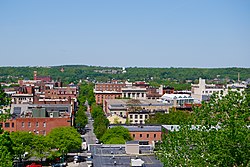Central Troy Historic District
|
Central Troy Historic District
|
|

View west over downtown Troy from RPI, 2009
|
|
| Location | Adams, 1st, 4th, Washington & Hill Sts., Franklin Pl., 5th Ave., Troy, NY |
|---|---|
| Coordinates | 42°43′39″N 73°41′27″W / 42.72750°N 73.69083°WCoordinates: 42°43′39″N 73°41′27″W / 42.72750°N 73.69083°W |
| Area | 96 acres (39 ha) |
| Built | 1787-1940 |
| Architect | Various |
| Architectural style | Greek Revival, Victorian, Classical Revival |
| NRHP Reference # |
86001527 (original) 16000367 (increase) |
| Significant dates | |
| Added to NRHP | 1986 |
| Boundary increase | June 14, 2016 |
The Central Troy Historic District is an irregularly shaped, 96-acre (39 ha) area of downtown Troy, New York, United States. It has been described as "one of the most perfectly preserved 19th-century downtowns in the [country]" with nearly 700 properties in a variety of architectural styles from the early 19th to mid-20th centuries. These include most of Russell Sage College, one of two privately owned urban parks in New York, and two National Historic Landmarks. Visitors ranging from the Duke de la Rochefoucauld to Philip Johnson have praised aspects of it. Martin Scorsese used parts of downtown Troy as a stand-in for 19th-century Manhattan in The Age of Innocence.
In 1986, it was added to the National Register of Historic Places (NRHP), superseding five smaller historic districts that had been listed on the Register in the early 1970s. (Two years later, in 1988, the extension of the previous River Street Historic District north of Federal Street was added separately to the NRHP as the Northern River Street Historic District.) In late 2014, the State Historic Preservation Board began considering an adjustment to the district's boundaries that would be a net expansion, particularly in its southeast; that increase was made official in 2016. Most of the buildings, structures and objects within the district contribute to its historic character. Two of Troy's four National Historic Landmarks, the Gurley Building and Troy Savings Bank, are located within its boundaries. Nine other buildings are listed on the Register in their own right. Among the architects represented are Alexander Jackson Davis, George B. Post, Calvert Vaux and Frederick Clarke Withers. There are many buildings designed by the regionally significant architect Marcus F. Cummings. The downtown street plan was borrowed from Philadelphia, and one neighborhood, Washington Square, was influenced by London's squares of its era.
...
Wikipedia


